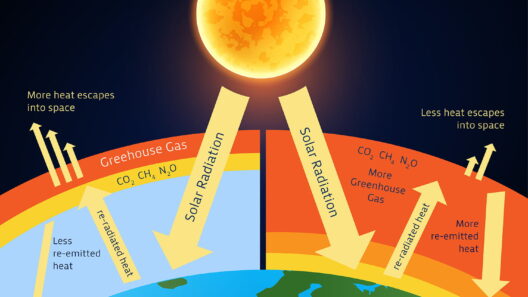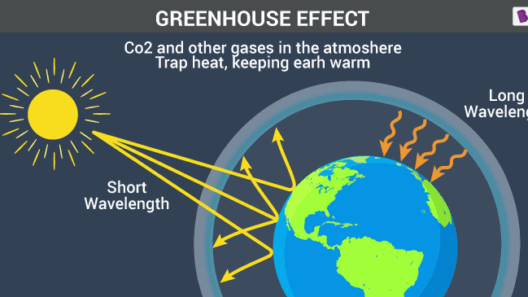Have you ever gazed up at the sky on a clear day and marveled at its brilliance? Now consider if that same sky became perpetually shrouded in haze and smog. The greenhouse effect, while a natural phenomenon, is being exacerbated by human activities, leading to climate change and environmental degradation. This raises a critical inquiry: How can we curtail the impact of greenhouse gases? Let’s delve into pragmatic strategies individuals, communities, and nations can adopt to tackle this pressing issue.
Understanding the Mechanisms of the Greenhouse Effect
Before we can effectively address the greenhouse effect, it is crucial to comprehend its mechanics. The greenhouse effect occurs when certain gases in Earth’s atmosphere trap heat, preventing it from radiating back into space. These gases—carbon dioxide, methane, nitrous oxide, and fluorinated gases—are often products of anthropogenic activities such as industrial processes, fossil fuel combustion, and deforestation.
This leads to the heating of the planet, more commonly referred to as global warming. The ramifications of this warming include devastating weather patterns, rising sea levels, and disruptions to biodiversity. Language and dialogue surrounding climate change can sometimes feel abstract or distant, yet the consequences are palpably experienced by individuals around the globe. Thus, the question remains: how do we reverse this trend?
Adopting Renewable Energy Sources
A potent antidote to greenhouse gas emissions lies in the embrace of renewable energy. Solar, wind, hydroelectric, and geothermal energies present an array of possibilities. Transitioning from fossil fuels to renewable sources not only reduces emissions but also diminishes dependency on non-renewable resources, contributing to energy security.
For instance, the installation of solar panels on residential rooftops serves a dual purpose: generating electricity and minimizing carbon footprints. Beyond individual action, communities can band together to invest in renewable energy projects, fostering a collective commitment to sustainable practices. Wind farms and solar parks can provide energy not only for local households but also for surrounding industries, creating a ripple effect of eco-consciousness.
Implementing Energy Efficiency Measures
Energy efficiency is another crucial component in the quest to mitigate greenhouse emissions. Improving the efficiency of homes, businesses, and transportation can lead to significant reductions in energy consumption. Simple measures such as using energy-efficient appliances, insulating homes, and utilizing smart thermostats can yield both immediate and long-term benefits.
Consider the impact of public transportation. Encouraging the use of buses, trains, and carpools alleviates traffic congestion, reduces emissions, and conserves energy. As society embraces a more communal approach to travel, the carbon footprint shrinks remarkably. Yet, transitioning to public transportation requires a cultural shift—a challenge that requires the cooperation of local governments and citizens alike.
Emphasizing Sustainable Agriculture
The food system is intricately tied to the greenhouse effect, with agriculture contributing a significant portion of global emissions. Elevating sustainable farming practices, such as crop rotation, organic farming, and agroforestry, can reduce the impact. These methods enhance soil health, sequester carbon, and minimize the use of synthetic fertilizers that emit nitrous oxide.
Moreover, reducing food waste is paramount. An estimated one-third of global food production is wasted, which translates to significant waste of resources and subsequent emissions from decomposing organic matter in landfills. By advocating for better food management practices—from production to consumption—society can champion the cause of reducing emissions at every stage of the food lifecycle.
Reforestation and Afforestation Efforts
Forests act as carbon sinks, absorbing excessive carbon dioxide from the atmosphere. Therefore, reforestation and afforestation initiatives are instrumental in combating the greenhouse effect. Planting trees is not only vital for sequestering carbon but also for restoring biodiversity and enhancing ecosystem resilience. Communities can engage in tree-planting campaigns, promoting local biodiversity and fostering a connection to nature.
Not only do these initiatives enthrall community spirit, but they also replenish habitats for myriad species. However, hurdles exist in maintaining these forests and ensuring proper stewardship. Financing, long-term commitments, and local engagement are essential ingredients for success. Thus, the challenge is not simply planting trees; it is nurturing them to ensure enduring health.
Encouraging Individual Responsibility
The power of the individual should not be underestimated. Simple lifestyle changes can substantially contribute to a collective effort in reducing greenhouse gas emissions. Reducing meat consumption, opting for locally-sourced products, and minimizing single-use plastics—all of these choices can lead to significant cumulative effects.
This invites a playful yet serious challenge: Can individuals commit to a “green challenge”? Whether it’s a meatless Monday or a pledge to avoid plastic for a week, these small changes can alter habitual consumer behavior and engender widespread environmental benefits.
Advocating for Policy Change
Policy change is a critical aspect of effectively combating the greenhouse effect. Governments play a pivotal role in establishing regulations and incentives that promote sustainable practices. Advocacy for climate-friendly legislation—ranging from carbon pricing to stricter emissions standards—can induce meaningful shifts in corporate behavior and societal norms.
Civic engagement is indispensable in this domain; citizens must communicate with their representatives, express their concerns, and push for legislative frameworks that prioritize sustainability. Change can sprout from the grassroots, culminating in legislative victories that align with broader climate goals.
Conclusion: A Collective Effort to Shape a Sustainable Future
Combating the greenhouse effect requires a multifaceted approach, involving individuals, communities, and governments alike. By adopting renewable energy, enhancing energy efficiency, promoting sustainable agriculture, investing in reforestation, and advocating for policy change, we can forge a path to a more sustainable future.
The relentless pursuit of a harmonious relationship between humanity and nature is not just a challenge; it is an opportunity to innovate and inspire. The question remains: Are we ready to accept this challenge and do our part?







